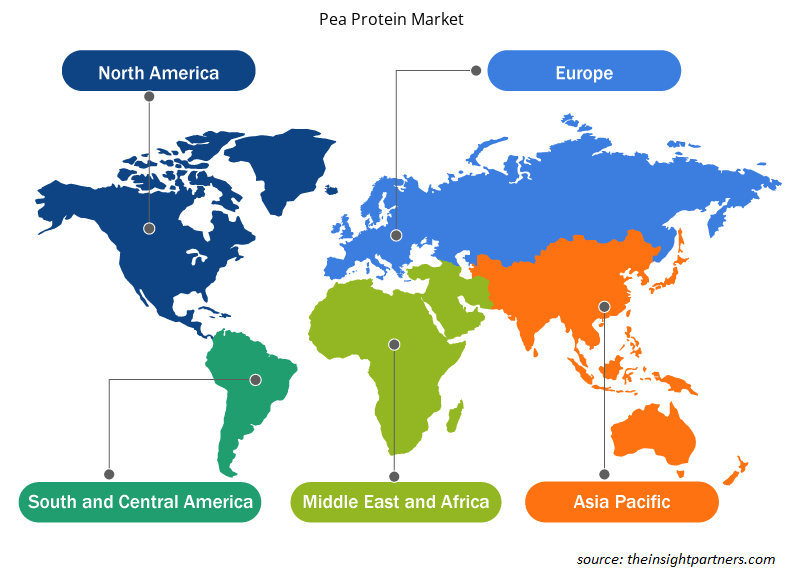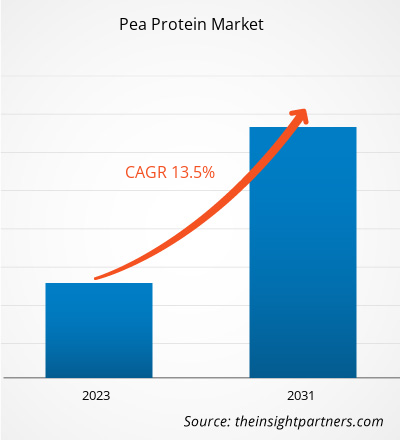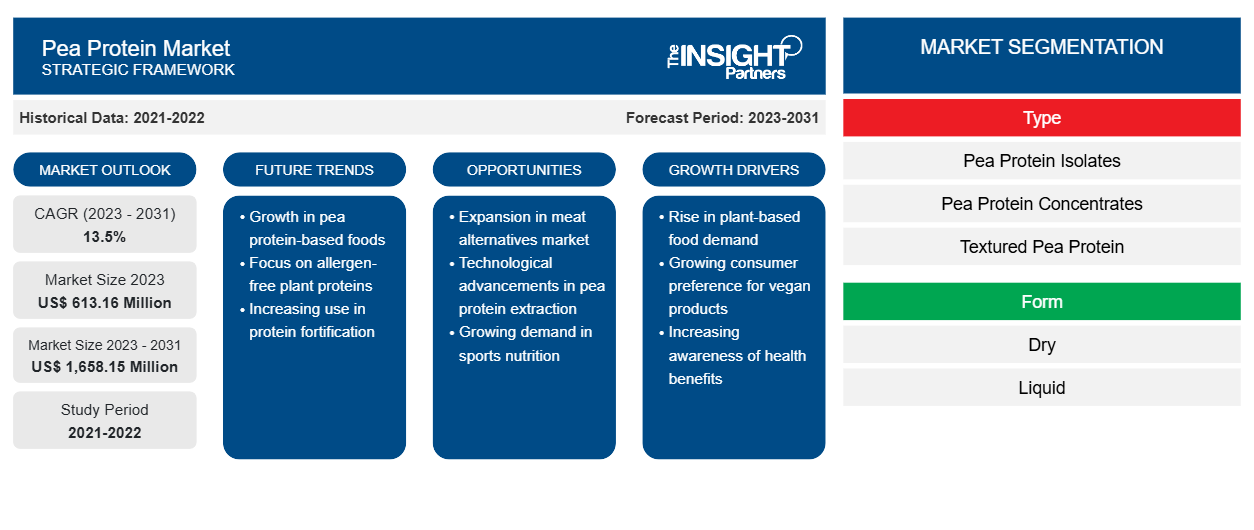Si prevede che la dimensione del mercato delle proteine di piselli raggiungerà 1.658,15 milioni di dollari entro il 2031, rispetto ai 613,16 milioni di dollari del 2023. Si prevede che il mercato registrerà un CAGR del 13,5% nel 2023-2031. Le vendite brillanti di proteine di piselli come fonte proteica negli alimenti per animali domestici e nei mangimi per animali rimarranno probabilmente le tendenze chiave del mercato delle proteine di piselli.
Analisi del mercato delle proteine dei piselli
Il mercato delle proteine di piselli sta crescendo a un ritmo significativo grazie a fattori quali una maggiore consapevolezza della salute, molteplici benefici per la salute e una maggiore domanda di alternative alle proteine della carne. Inoltre, fattori quali la tendenza a vivere utilizzando le proteine di piselli in vari prodotti, il costante aumento delle industrie alimentari e delle bevande, la maggiore domanda di alimenti biologici e le innovazioni nei prodotti a base di proteine, hanno integrato la crescita del mercato globale delle proteine di piselli. Il crescente numero di consumatori alla ricerca di etichette più semplici, ottimo gusto e fonti proteiche alternative per risolvere scelte nutrizionali personalizzate che a loro volta possono accelerare la crescita del mercato delle proteine di piselli. Tuttavia, la disponibilità di proteine sostitutive e la scarsa consapevolezza dei consumatori sui prodotti a base di proteine di piselli possono limitare la crescita del mercato nel periodo di previsione.
Panoramica del mercato delle proteine dei piselli
La proteina di pisello si ottiene dai piselli spezzati verdi e gialli e viene usata principalmente per produrre proteine in polvere. Spesso funge da base in alimenti confezionati come hamburger vegetariani, maionese vegana e sostituisce persino i latticini in alcuni gelati e latte. La proteina di pisello è un'eccellente fonte di ferro. Viene aggiunta a prodotti alimentari come frullati e frappè per aumentare il contenuto proteico ed è anche un'ottima scelta per quasi tutte le diete poiché è naturalmente vegana e ipoallergenica. La proteina di pisello contiene nove amminoacidi essenziali che il corpo umano non può creare.
Personalizza questo report in base alle tue esigenze
Riceverai la personalizzazione gratuita di qualsiasi report, comprese parti di questo report, o analisi a livello nazionale, pacchetto dati Excel, oltre a usufruire di grandi offerte e sconti per start-up e università
- Scopri le principali tendenze di mercato in questo rapporto.Questo campione GRATUITO includerà analisi di dati che spaziano dalle tendenze di mercato alle stime e alle previsioni.
Driver e opportunità del mercato delle proteine dei piselli
La crescente domanda di integratori alimentari favorisce il mercato
Le proteine di pisello sono utilizzate nei nutraceutici come integratori alimentari e per la salute e per la salute dell'apparato digerente. Un integratore alimentare viene assunto per via orale sotto forma di compressa, capsula, pillola o liquido. Gli integratori alimentari sono prodotti alimentari che contengono minerali, vitamine, erbe o altri elementi botanici o aminoacidi. Le proteine di pisello sono indotte negli integratori alimentari in modo che possano fornire una fonte esterna di vitamine, minerali , fibre e altri ingredienti essenziali al consumatore. La crescente domanda di questi integratori alimentari tra i consumatori ha guidato la crescita del mercato.nutraceuticals such as dietary and health supplements, and for digestive health. A dietary supplement is consumed orally either as a tablet, capsule, pill, or a liquid. Dietary supplements are food products that contain mineral, vitamin, herb or other botanicals, or amino acids. Pea proteins are induced in dietary supplements so that they can provide an external source of vitamins,
Crescente domanda di nutrizione sportiva a base di proteine di piselli e altri prodotti per il benessere
Le varie proprietà funzionali delle proteine di pisello, l'emulsione, il miglioramento della consistenza e la formazione di schiuma hanno ampliato il loro potenziale di mercato. I principali attori del mercato stanno prendendo iniziative per sviluppare prodotti che utilizzano le proteine di pisello, per soddisfare la domanda dei consumatori.
Analisi della segmentazione del rapporto di mercato delle proteine dei piselli
I segmenti chiave che hanno contribuito alla derivazione dell'analisi del mercato delle proteine di piselli sono tipo, forma e applicazione.
- In base alla tipologia, il mercato delle proteine di pisello è suddiviso in isolati proteici di pisello, concentrati proteici di pisello e proteine di pisello testurizzate.
- In base alla forma, il mercato si divide in secco e liquido.
- In termini di applicazione, il mercato è segmentato in integratori alimentari, prodotti da forno e dolciari, alternative alla carne, bevande e altri.
Analisi della quota di mercato delle proteine dei piselli per area geografica
L'ambito geografico del rapporto sul mercato delle proteine dei piselli è suddiviso principalmente in cinque regioni: Nord America, Asia Pacifico, Europa, Medio Oriente e Africa e Sud America/Sud e Centro America.
Il Nord America ha dominato il mercato delle proteine di piselli. Il crescente interesse dei consumatori per le alternative non a base di carne, come risultato delle crescenti preoccupazioni verso uno stile di vita sano, ha permesso ai produttori del Nord America di incorporare ingredienti vegetali di alta qualità . Un aumento delle questioni relative all'ambiente e un'impennata di consapevolezza verso il benessere degli animali hanno spostato l'attenzione verso proteine alternative derivate da proteine vegetali. Si prevede che l'Asia Pacifica crescerà con il CAGR più elevato nei prossimi anni.
Approfondimenti regionali sul mercato delle proteine dei piselli
Le tendenze regionali e i fattori che influenzano il mercato delle proteine dei piselli durante il periodo di previsione sono stati ampiamente spiegati dagli analisti di Insight Partners. Questa sezione discute anche i segmenti e la geografia del mercato delle proteine dei piselli in Nord America, Europa, Asia Pacifico, Medio Oriente e Africa e Sud e Centro America.

- Ottieni i dati specifici regionali per il mercato delle proteine dei piselli
Ambito del rapporto sul mercato delle proteine dei piselli
| Attributo del report | Dettagli |
|---|---|
| Dimensioni del mercato nel 2023 | 613,16 milioni di dollari USA |
| Dimensioni del mercato entro il 2031 | 1.658,15 milioni di dollari USA |
| CAGR globale (2023-2031) | 13,5% |
| Dati storici | 2021-2022 |
| Periodo di previsione | 2023-2031 |
| Segmenti coperti | Per tipo
|
| Regioni e Paesi coperti | America del Nord
|
| Leader di mercato e profili aziendali chiave |
|
Densità degli attori del mercato: comprendere il suo impatto sulle dinamiche aziendali
Il mercato del mercato delle proteine dei piselli sta crescendo rapidamente, spinto dalla crescente domanda degli utenti finali dovuta a fattori quali l'evoluzione delle preferenze dei consumatori, i progressi tecnologici e una maggiore consapevolezza dei benefici del prodotto. Con l'aumento della domanda, le aziende stanno ampliando le loro offerte, innovando per soddisfare le esigenze dei consumatori e capitalizzando sulle tendenze emergenti, il che alimenta ulteriormente la crescita del mercato.
La densità degli operatori di mercato si riferisce alla distribuzione di aziende o società che operano in un particolare mercato o settore. Indica quanti concorrenti (operatori di mercato) sono presenti in un dato spazio di mercato in relazione alle sue dimensioni o al valore di mercato totale.
Le principali aziende che operano nel mercato delle proteine di piselli sono:
- A&B Ingredients e Axiom Foods, Inc.
- Società di Nutrascience di Burcon
- Cosucra Groupe Warcoing SA
- Industrie Gemef
- Integratori alimentari Glanbia
- Puris, Fratelli Roquette
Disclaimer : le aziende elencate sopra non sono classificate secondo un ordine particolare.

- Ottieni una panoramica dei principali attori del mercato delle proteine dei piselli
Notizie e sviluppi recenti sul mercato delle proteine dei piselli
Il mercato delle proteine di pisello viene valutato raccogliendo dati qualitativi e quantitativi post-ricerca primaria e secondaria, che includono importanti pubblicazioni aziendali, dati di associazioni e database. Di seguito è riportato un elenco degli sviluppi nel mercato dei disturbi del linguaggio e della parola e delle strategie:
- A gennaio 2023, Burcon NutraScience Corporation, leader tecnologico globale nello sviluppo di proteine vegetali per alimenti e bevande, è lieta di annunciare di aver ricevuto una notifica di autorizzazione dall'Ufficio brevetti e marchi degli Stati Uniti ("USPTO") per una domanda di brevetto che copre le caratteristiche della proteina di pisello Peazazz® di Burcon realizzata con l'esclusivo processo di Burcon. Una notifica di autorizzazione dall'USPTO è una notifica scritta che una domanda di brevetto ha superato la revisione interna, è in attesa di rilascio e verrà concessa nel prossimo futuro. (Fonte: Burcon NutraScience Corporation, comunicato stampa/sito Web aziendale/newsletter, 2023)
Copertura e risultati del rapporto sul mercato delle proteine dei piselli
Il rapporto "Dimensioni e previsioni del mercato delle proteine dei piselli (2021-2031)" fornisce un'analisi dettagliata del mercato che copre le seguenti aree:
- Dimensioni e previsioni del mercato a livello globale, regionale e nazionale per tutti i segmenti di mercato chiave coperti dall'ambito
- Dinamiche di mercato come fattori trainanti, vincoli e opportunità chiave
- Principali tendenze future
- Analisi dettagliata delle cinque forze PEST/Porter e SWOT
- Analisi di mercato globale e regionale che copre le principali tendenze di mercato, i principali attori, le normative e gli sviluppi recenti del mercato
- Analisi del panorama industriale e della concorrenza che copre la concentrazione del mercato, l'analisi della mappa di calore, i principali attori e gli sviluppi recenti
- Profili aziendali dettagliati
- Analisi storica (2 anni), anno base, previsione (7 anni) con CAGR
- Analisi PEST e SWOT
- Valore/volume delle dimensioni del mercato - Globale, Regionale, Nazionale
- Industria e panorama competitivo
- Set di dati Excel
Report recenti
Testimonianze
Motivo dell'acquisto
- Processo decisionale informato
- Comprensione delle dinamiche di mercato
- Analisi competitiva
- Analisi dei clienti
- Previsioni di mercato
- Mitigazione del rischio
- Pianificazione strategica
- Giustificazione degli investimenti
- Identificazione dei mercati emergenti
- Miglioramento delle strategie di marketing
- Aumento dell'efficienza operativa
- Allineamento alle tendenze normative























 Ottieni un campione gratuito per - Mercato delle proteine dei piselli
Ottieni un campione gratuito per - Mercato delle proteine dei piselli